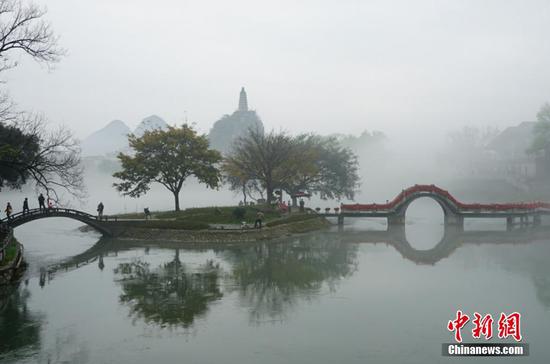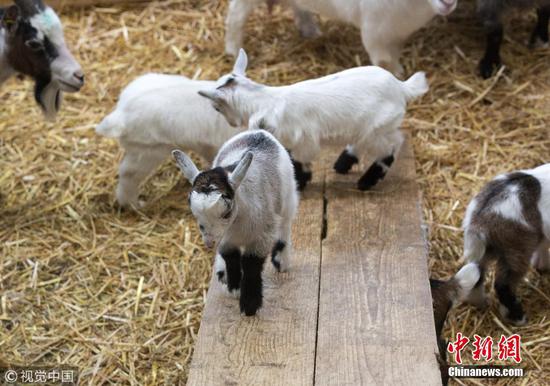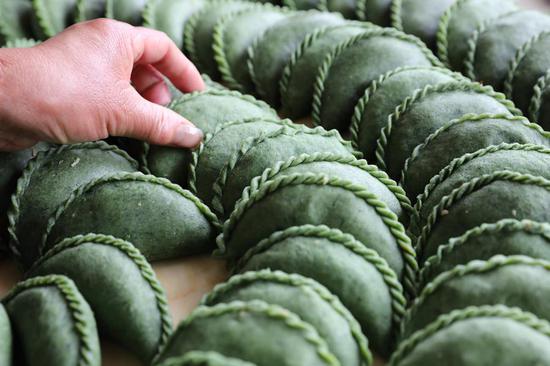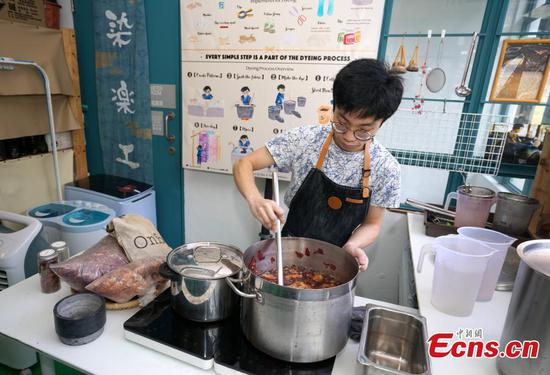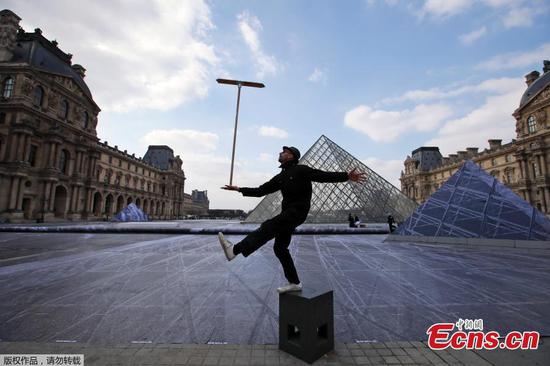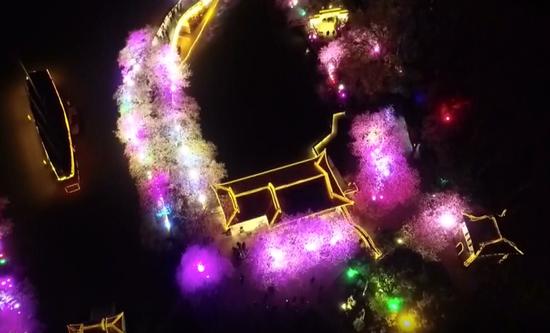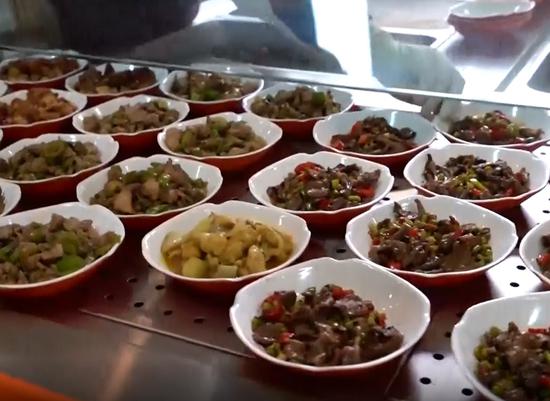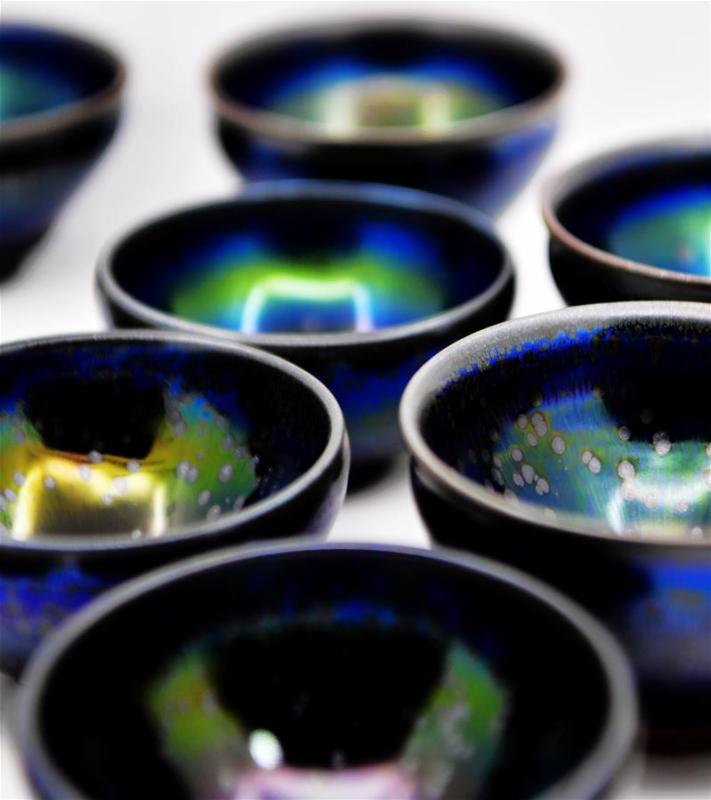
Photo taken on March 28, 2019 shows pieces of porcelain made by Wu Lizhu, inheritor of the workmanship of Jianzhan teaware, at his workshop in Jianyang District of Nanping City, south China's Fujian Province. Jianzhan teaware, a well-known Chinese porcelain originated in Jianyang, dates back to more than 1,000 years ago in Song dynasty (960-1279). It was the best teaware for scholars and literati to use during that time in tea competitions. Jianzhan teawares are known for their variability. Glazes can range in color from dark plum to yellow, green, and blue. During the heating and cooling processes, iron element in the clay can migrate within the glaze to form surface crystals in rich and glossy colors, as in the "oil spot" or "partridge feather" patterns. Among all the Jianzhan teawares, the most rare and precious type is called "Yaobian", the workmanship of which has been lost for over 700 years. Local craftsmen have been spending years of effort to replicate the original "Yaobian" Jianzhan teawares. The workmanship of Jianzhan teaware was listed as national intangible cultural heritage in 2011. (Xinhua/Wei Peiquan)
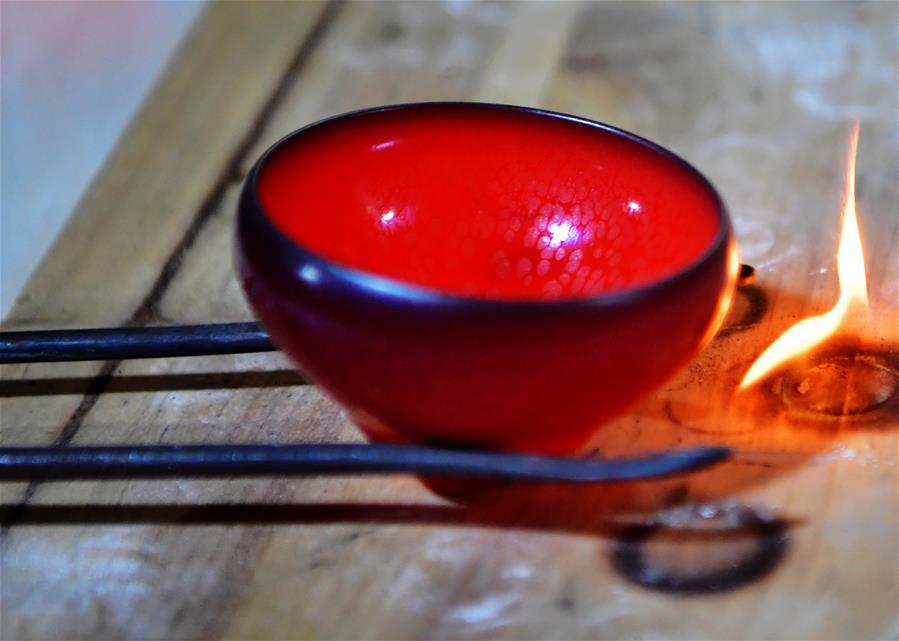
Wu Lizhu, inheritor of the workmanship of Jianzhan teaware, takes a piece of porcelain out from the kiln at his workshop in Jianyang District of Nanping City, south China's Fujian Province, March 28, 2019. Jianzhan teaware, a well-known Chinese porcelain originated in Jianyang, dates back to more than 1,000 years ago in Song dynasty (960-1279). It was the best teaware for scholars and literati to use during that time in tea competitions. Jianzhan teawares are known for their variability. Glazes can range in color from dark plum to yellow, green, and blue. During the heating and cooling processes, iron element in the clay can migrate within the glaze to form surface crystals in rich and glossy colors, as in the "oil spot" or "partridge feather" patterns. Among all the Jianzhan teawares, the most rare and precious type is called "Yaobian", the workmanship of which has been lost for over 700 years. Local craftsmen have been spending years of effort to replicate the original "Yaobian" Jianzhan teawares. The workmanship of Jianzhan teaware was listed as national intangible cultural heritage in 2011. (Xinhua/Wei Peiquan)
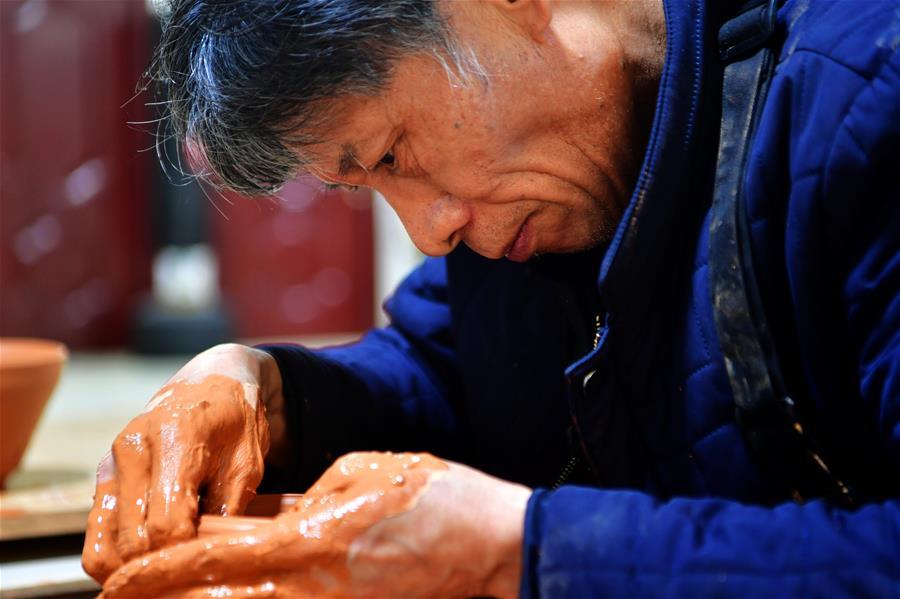
Wu Lizhu, inheritor of the workmanship of Jianzhan teaware, makes a piece of porcelain at his workshop in Jianyang District of Nanping City, south China's Fujian Province, March 28, 2019. Jianzhan teaware, a well-known Chinese porcelain originated in Jianyang, dates back to more than 1,000 years ago in Song dynasty (960-1279). It was the best teaware for scholars and literati to use during that time in tea competitions. Jianzhan teawares are known for their variability. Glazes can range in color from dark plum to yellow, green, and blue. During the heating and cooling processes, iron element in the clay can migrate within the glaze to form surface crystals in rich and glossy colors, as in the "oil spot" or "partridge feather" patterns. Among all the Jianzhan teawares, the most rare and precious type is called "Yaobian", the workmanship of which has been lost for over 700 years. Local craftsmen have been spending years of effort to replicate the original "Yaobian" Jianzhan teawares. The workmanship of Jianzhan teaware was listed as national intangible cultural heritage in 2011. (Xinhua/Wei Peiquan)
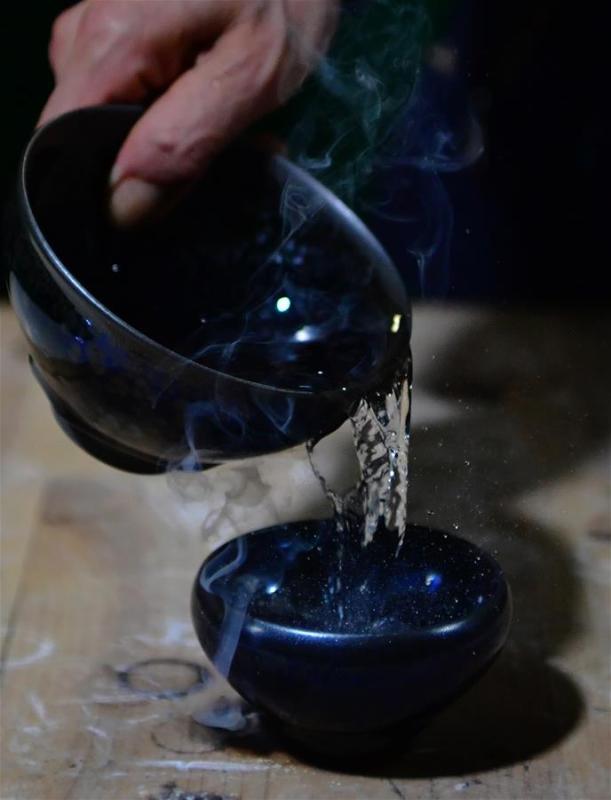
Wu Lizhu, inheritor of the workmanship of Jianzhan teaware, cools a piece of porcelain at his workshop in Jianyang District of Nanping City, south China's Fujian Province, March 28, 2019. Jianzhan teaware, a well-known Chinese porcelain originated in Jianyang, dates back to more than 1,000 years ago in Song dynasty (960-1279). It was the best teaware for scholars and literati to use during that time in tea competitions. Jianzhan teawares are known for their variability. Glazes can range in color from dark plum to yellow, green, and blue. During the heating and cooling processes, iron element in the clay can migrate within the glaze to form surface crystals in rich and glossy colors, as in the "oil spot" or "partridge feather" patterns. Among all the Jianzhan teawares, the most rare and precious type is called "Yaobian", the workmanship of which has been lost for over 700 years. Local craftsmen have been spending years of effort to replicate the original "Yaobian" Jianzhan teawares. The workmanship of Jianzhan teaware was listed as national intangible cultural heritage in 2011. (Xinhua/Wei Peiquan)
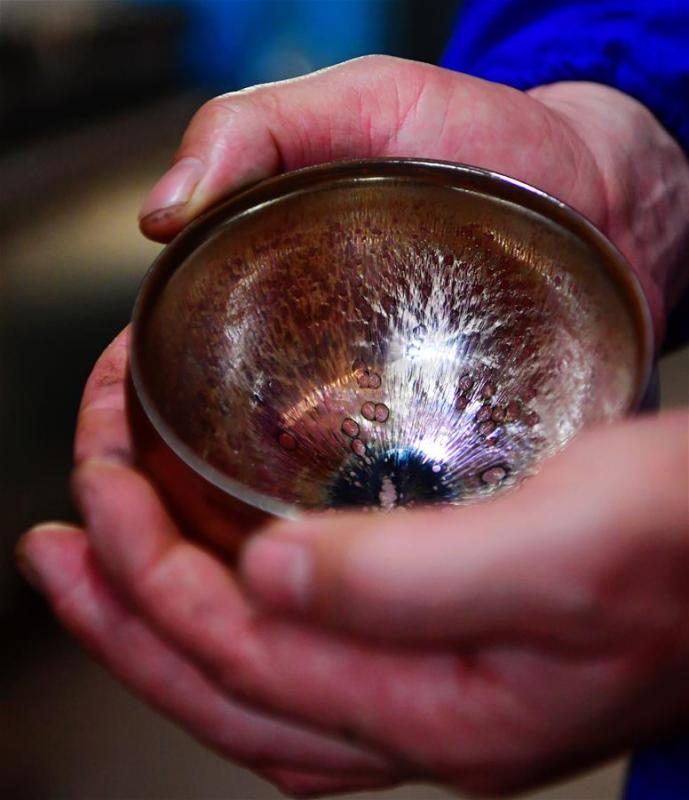
Wu Zhoufu, inheritor of the workmanship of Jianzhan teaware, shows a piece of porcelain at his workshop in Jianyang District of Nanping City, south China's Fujian Province, March 28, 2019. Jianzhan teaware, a well-known Chinese porcelain originated in Jianyang, dates back to more than 1,000 years ago in Song dynasty (960-1279). It was the best teaware for scholars and literati to use during that time in tea competitions. Jianzhan teawares are known for their variability. Glazes can range in color from dark plum to yellow, green, and blue. During the heating and cooling processes, iron element in the clay can migrate within the glaze to form surface crystals in rich and glossy colors, as in the "oil spot" or "partridge feather" patterns. Among all the Jianzhan teawares, the most rare and precious type is called "Yaobian", the workmanship of which has been lost for over 700 years. Local craftsmen have been spending years of effort to replicate the original "Yaobian" Jianzhan teawares. The workmanship of Jianzhan teaware was listed as national intangible cultural heritage in 2011. (Xinhua/Wei Peiquan)
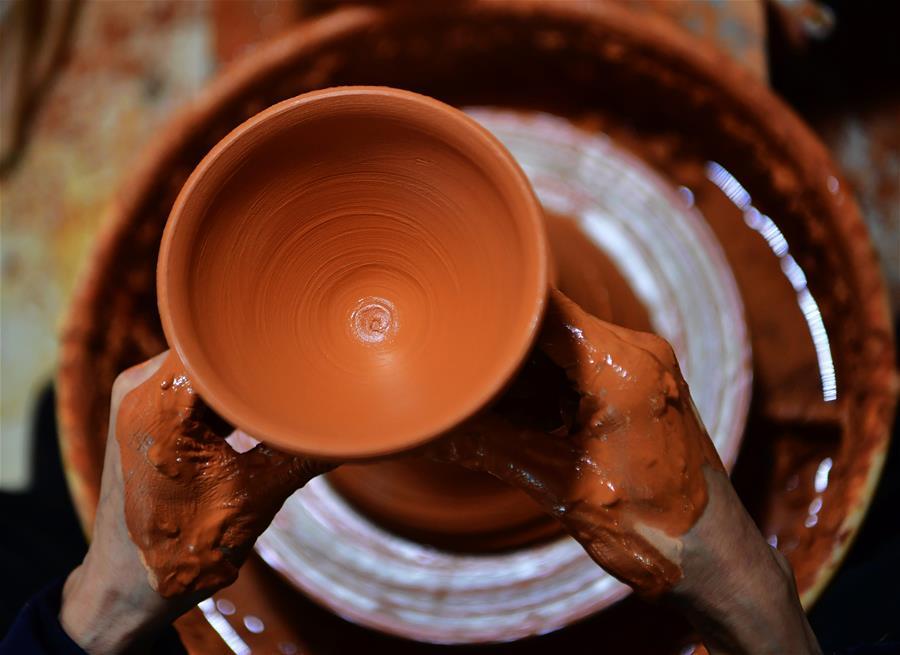
Wu Lizhu, inheritor of the workmanship of Jianzhan teaware, makes a piece of porcelain at his workshop in Jianyang District of Nanping City, south China's Fujian Province, March 28, 2019. Jianzhan teaware, a well-known Chinese porcelain originated in Jianyang, dates back to more than 1,000 years ago in Song dynasty (960-1279). It was the best teaware for scholars and literati to use during that time in tea competitions. Jianzhan teawares are known for their variability. Glazes can range in color from dark plum to yellow, green, and blue. During the heating and cooling processes, iron element in the clay can migrate within the glaze to form surface crystals in rich and glossy colors, as in the "oil spot" or "partridge feather" patterns. Among all the Jianzhan teawares, the most rare and precious type is called "Yaobian", the workmanship of which has been lost for over 700 years. Local craftsmen have been spending years of effort to replicate the original "Yaobian" Jianzhan teawares. The workmanship of Jianzhan teaware was listed as national intangible cultural heritage in 2011. (Xinhua/Wei Peiquan)
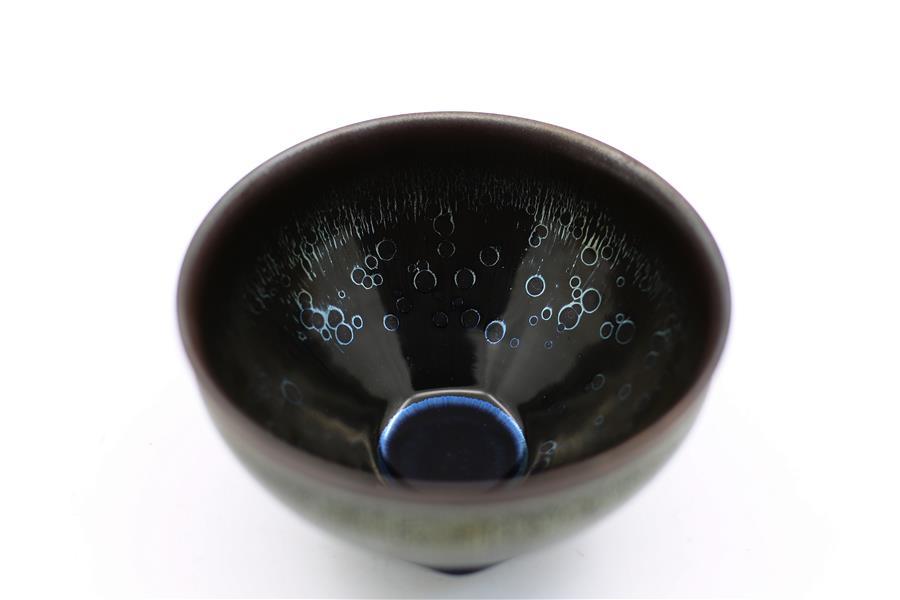
Photo taken on March 28, 2019 shows a piece of porcelain made by Wu Lizhu, inheritor of the workmanship of Jianzhan teaware, at his workshop in Jianyang District of Nanping City, south China's Fujian Province. Jianzhan teaware, a well-known Chinese porcelain originated in Jianyang, dates back to more than 1,000 years ago in Song dynasty (960-1279). It was the best teaware for scholars and literati to use during that time in tea competitions. Jianzhan teawares are known for their variability. Glazes can range in color from dark plum to yellow, green, and blue. During the heating and cooling processes, iron element in the clay can migrate within the glaze to form surface crystals in rich and glossy colors, as in the "oil spot" or "partridge feather" patterns. Among all the Jianzhan teawares, the most rare and precious type is called "Yaobian", the workmanship of which has been lost for over 700 years. Local craftsmen have been spending years of effort to replicate the original "Yaobian" Jianzhan teawares. The workmanship of Jianzhan teaware was listed as national intangible cultural heritage in 2011. (Xinhua/An Xiya)
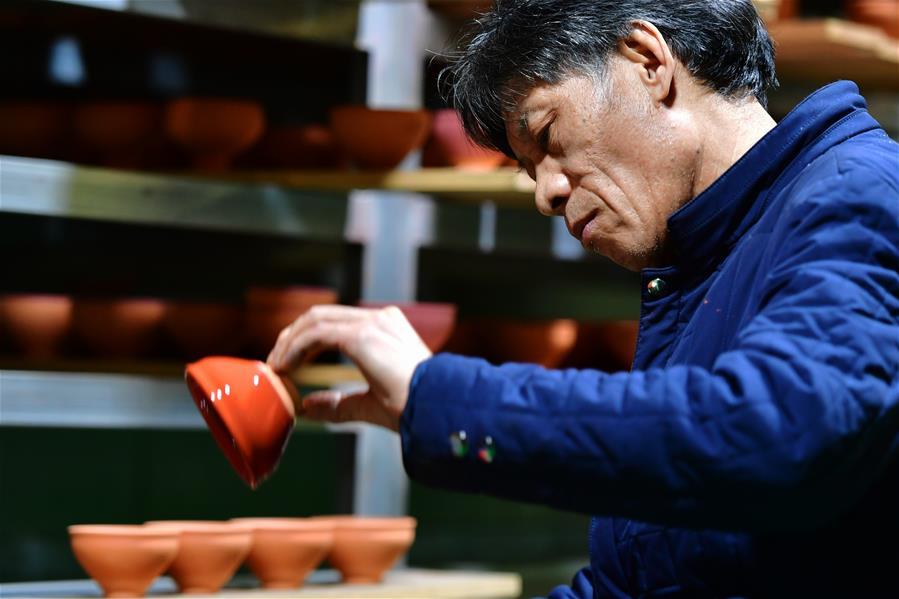
Wu Lizhu, inheritor of the workmanship of Jianzhan teaware, glazes a piece of porcelain at his workshop in Jianyang District of Nanping City, south China's Fujian Province, March 28, 2019. Jianzhan teaware, a well-known Chinese porcelain originated in Jianyang, dates back to more than 1,000 years ago in Song dynasty (960-1279). It was the best teaware for scholars and literati to use during that time in tea competitions. Jianzhan teawares are known for their variability. Glazes can range in color from dark plum to yellow, green, and blue. During the heating and cooling processes, iron element in the clay can migrate within the glaze to form surface crystals in rich and glossy colors, as in the "oil spot" or "partridge feather" patterns. Among all the Jianzhan teawares, the most rare and precious type is called "Yaobian", the workmanship of which has been lost for over 700 years. Local craftsmen have been spending years of effort to replicate the original "Yaobian" Jianzhan teawares. The workmanship of Jianzhan teaware was listed as national intangible cultural heritage in 2011. (Xinhua/Wei Peiquan)
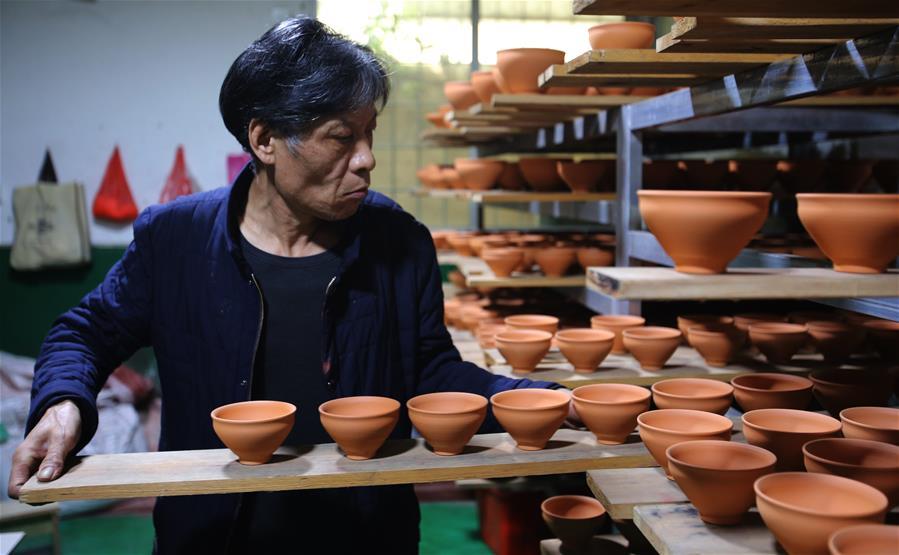
Wu Lizhu, inheritor of the workmanship of Jianzhan teaware, carries pieces of porcelain at his workshop in Jianyang District of Nanping City, south China's Fujian Province, March 28, 2019. Jianzhan teaware, a well-known Chinese porcelain originated in Jianyang, dates back to more than 1,000 years ago in Song dynasty (960-1279). It was the best teaware for scholars and literati to use during that time in tea competitions. Jianzhan teawares are known for their variability. Glazes can range in color from dark plum to yellow, green, and blue. During the heating and cooling processes, iron element in the clay can migrate within the glaze to form surface crystals in rich and glossy colors, as in the "oil spot" or "partridge feather" patterns. Among all the Jianzhan teawares, the most rare and precious type is called "Yaobian", the workmanship of which has been lost for over 700 years. Local craftsmen have been spending years of effort to replicate the original "Yaobian" Jianzhan teawares. The workmanship of Jianzhan teaware was listed as national intangible cultural heritage in 2011. (Xinhua/An Xiya)
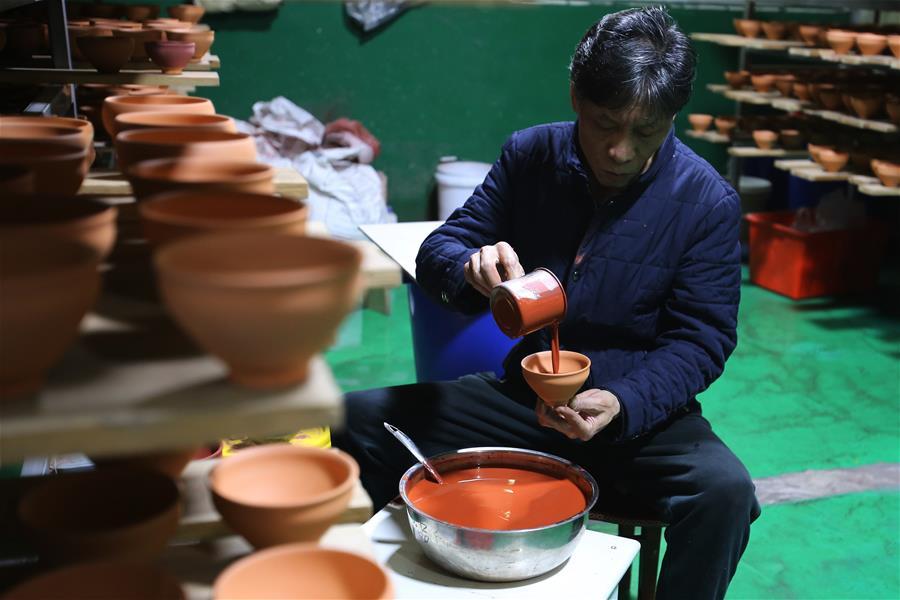
Wu Lizhu, inheritor of the workmanship of Jianzhan teaware, glazes a piece of porcelain at his workshop in Jianyang District of Nanping City, south China's Fujian Province, March 28, 2019. Jianzhan teaware, a well-known Chinese porcelain originated in Jianyang, dates back to more than 1,000 years ago in Song dynasty (960-1279). It was the best teaware for scholars and literati to use during that time in tea competitions. Jianzhan teawares are known for their variability. Glazes can range in color from dark plum to yellow, green, and blue. During the heating and cooling processes, iron element in the clay can migrate within the glaze to form surface crystals in rich and glossy colors, as in the "oil spot" or "partridge feather" patterns. Among all the Jianzhan teawares, the most rare and precious type is called "Yaobian", the workmanship of which has been lost for over 700 years. Local craftsmen have been spending years of effort to replicate the original "Yaobian" Jianzhan teawares. The workmanship of Jianzhan teaware was listed as national intangible cultural heritage in 2011. (Xinhua/An Xiya)
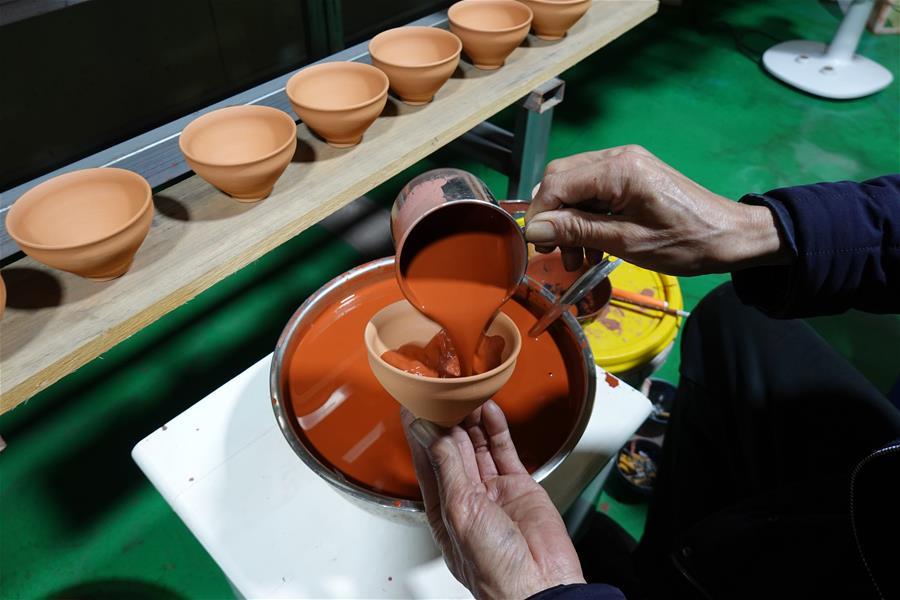
Wu Lizhu, inheritor of the workmanship of Jianzhan teaware, glazes a piece of porcelain at his workshop in Jianyang District of Nanping City, south China's Fujian Province, March 28, 2019. Jianzhan teaware, a well-known Chinese porcelain originated in Jianyang, dates back to more than 1,000 years ago in Song dynasty (960-1279). It was the best teaware for scholars and literati to use during that time in tea competitions. Jianzhan teawares are known for their variability. Glazes can range in color from dark plum to yellow, green, and blue. During the heating and cooling processes, iron element in the clay can migrate within the glaze to form surface crystals in rich and glossy colors, as in the "oil spot" or "partridge feather" patterns. Among all the Jianzhan teawares, the most rare and precious type is called "Yaobian", the workmanship of which has been lost for over 700 years. Local craftsmen have been spending years of effort to replicate the original "Yaobian" Jianzhan teawares. The workmanship of Jianzhan teaware was listed as national intangible cultural heritage in 2011. (Xinhua/Geng Xinning)
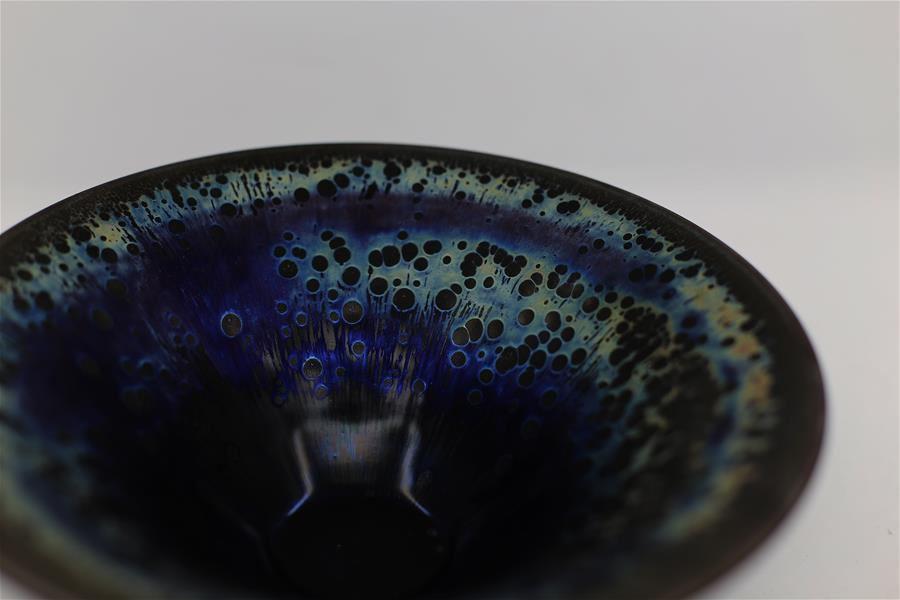
Photo taken on March 28, 2019 shows a piece of porcelain made by Wu Lizhu, inheritor of the workmanship of Jianzhan teaware, at his workshop in Jianyang District of Nanping City, south China's Fujian Province. Jianzhan teaware, a well-known Chinese porcelain originated in Jianyang, dates back to more than 1,000 years ago in Song dynasty (960-1279). It was the best teaware for scholars and literati to use during that time in tea competitions. Jianzhan teawares are known for their variability. Glazes can range in color from dark plum to yellow, green, and blue. During the heating and cooling processes, iron element in the clay can migrate within the glaze to form surface crystals in rich and glossy colors, as in the "oil spot" or "partridge feather" patterns. Among all the Jianzhan teawares, the most rare and precious type is called "Yaobian", the workmanship of which has been lost for over 700 years. Local craftsmen have been spending years of effort to replicate the original "Yaobian" Jianzhan teawares. The workmanship of Jianzhan teaware was listed as national intangible cultural heritage in 2011. (Xinhua/An Xiya)
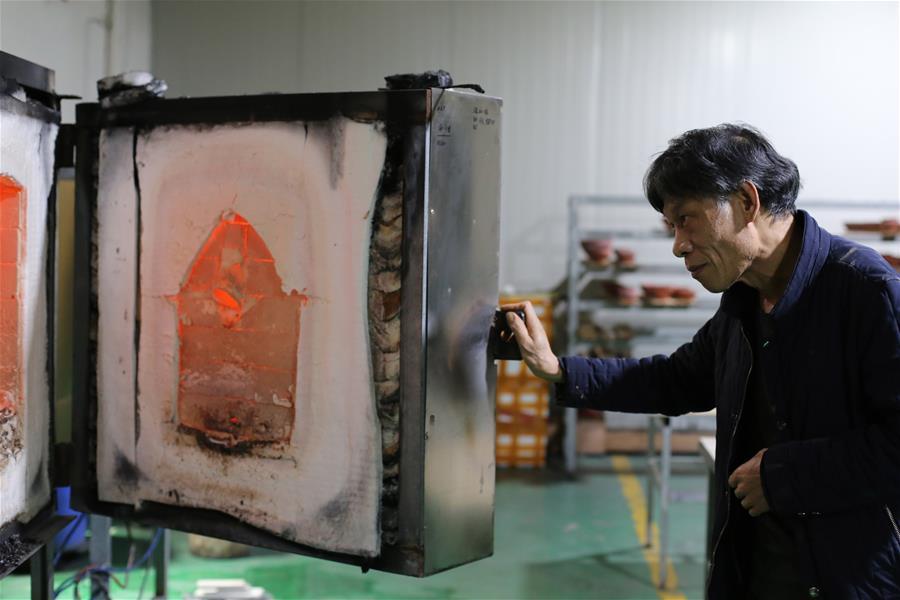
Wu Lizhu, inheritor of the workmanship of Jianzhan teaware, observes pieces of porcelain in the kiln at his workshop in Jianyang District of Nanping City, south China's Fujian Province, March 28, 2019. Jianzhan teaware, a well-known Chinese porcelain originated in Jianyang, dates back to more than 1,000 years ago in Song dynasty (960-1279). It was the best teaware for scholars and literati to use during that time in tea competitions. Jianzhan teawares are known for their variability. Glazes can range in color from dark plum to yellow, green, and blue. During the heating and cooling processes, iron element in the clay can migrate within the glaze to form surface crystals in rich and glossy colors, as in the "oil spot" or "partridge feather" patterns. Among all the Jianzhan teawares, the most rare and precious type is called "Yaobian", the workmanship of which has been lost for over 700 years. Local craftsmen have been spending years of effort to replicate the original "Yaobian" Jianzhan teawares. The workmanship of Jianzhan teaware was listed as national intangible cultural heritage in 2011. (Xinhua/An Xiya)
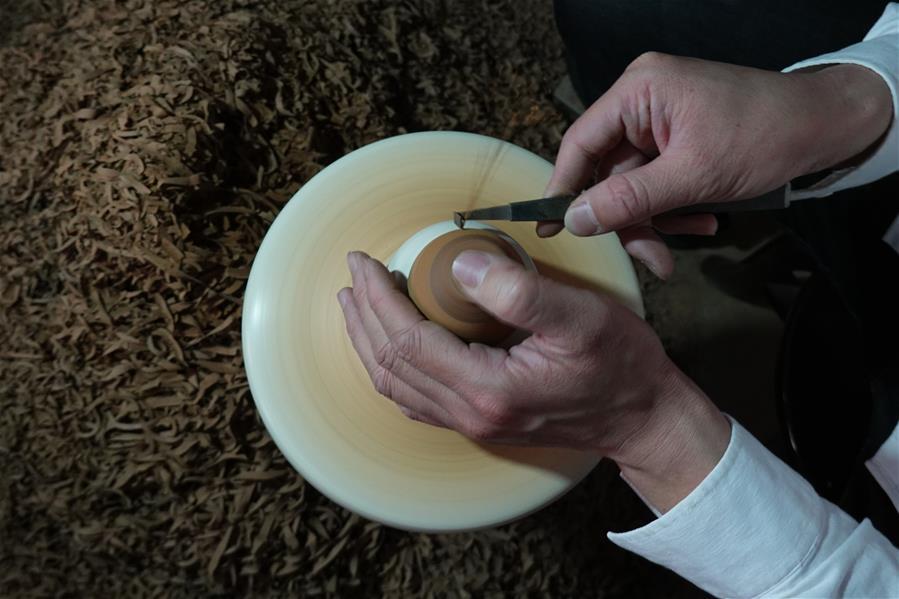
Chen Yufeng, inheritor of the workmanship of Jianzhan teaware, adjusts the shape of a piece of porcelain at his workshop in Jianyang District of Nanping City, south China's Fujian Province, March 28, 2019. Jianzhan teaware, a well-known Chinese porcelain originated in Jianyang, dates back to more than 1,000 years ago in Song dynasty (960-1279). It was the best teaware for scholars and literati to use during that time in tea competitions. Jianzhan teawares are known for their variability. Glazes can range in color from dark plum to yellow, green, and blue. During the heating and cooling processes, iron element in the clay can migrate within the glaze to form surface crystals in rich and glossy colors, as in the "oil spot" or "partridge feather" patterns. Among all the Jianzhan teawares, the most rare and precious type is called "Yaobian", the workmanship of which has been lost for over 700 years. Local craftsmen have been spending years of effort to replicate the original "Yaobian" Jianzhan teawares. The workmanship of Jianzhan teaware was listed as national intangible cultural heritage in 2011. (Xinhua/Geng Xinning)

